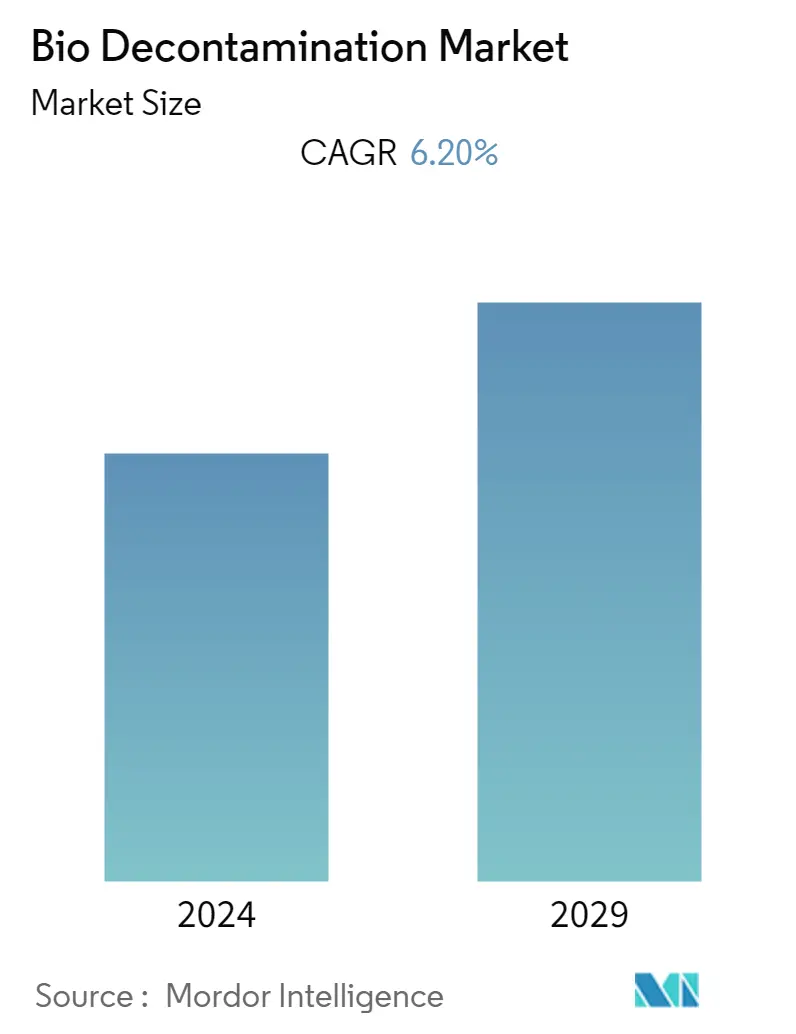Market Size of Bio Decontamination Industry

| Study Period | 2019 - 2029 |
| Base Year For Estimation | 2023 |
| CAGR | 6.20 % |
| Fastest Growing Market | Asia-Pacific |
| Largest Market | North America |
| Market Concentration | Medium |
Major Players
*Disclaimer: Major Players sorted in no particular order |
Need a report that reflects how COVID-19 has impacted this market and its growth?
Bio Decontamination Market Analysis
The bio-decontamination market is projected to register a CAGR of 6.2% during the forecast period.
As the impact of the COVID-19 outbreak widened and the number of patients admitted to hospitals grew, medical professionals and hospital administrators were looking for emergency alternatives that provided more beds for patients during the crisis by leveraging empty facilities, re-purposing space within an existing hospital, or building temporary structures to serve as hospitals. Hospital-acquired COVID-19 infections represent a serious public health issue, which is a problem that makes patients reluctant to seek hospital treatment for fear of becoming infected. As per the article published by NCBI in January 2021, despite numerous measures to contain the infection and limit its spread, cases of SARS-CoV-2 infections acquired in hospitals have been reported consistently during the pandemic. As per the same source, the SARS-CoV-2 hospital-acquired infection rate was 12-15% globally during the pandemic. Hence, due to the COVID-19 pandemic, the necessity to use sterilization has increased.
The increasing numbers of hospital-acquired COVID-19 infections and other secondary infections in the patients caused a surge in demand for bio-decontamination equipment and consumables to curb the spread of the disease and manage the conditionsrose in the affected patients. A study published in the Journal Lancet in September 2021 highlighted the increase in hospital-acquired infections (HAIs) in patients admitted to the hospital in the United Kingdom. It was found that over 11.3% of patients with COVID-19 in 314 United Kingdom hospitals got infections after hospital admission, and it increased to 15.8% during the pandemic. It was also observed that 6.8% of all patients with COVID-19 acquired nosocomial infections, and it increased to 8.2% of patients having nosocomial conditions during the pandemic. Thus, the COVID-19 outbreak has positively impacted the market's growth in its preliminary phase. Moreover, the market is expected to grow at a stable pace with the increasing cases of HAIs, which would drive the growth of bio-decontamination equipment and consumables globally.
The major factors driving the growth of the bio-decontamination market are the rising incidence of hospital-acquired infections (HAIs), the increasing number of surgical procedures, and the increasing outsourcing of bio-decontamination services.
The rising number of surgical wound infections, post-surgery infections, is predicted to drive the demand for bio-decontamination equipment and services to curb the infection rate. The number of surgeries is increasing, driven by the high burden of chronic diseases, cesarean birth procedures, trauma cases, etc. The chronic conditions of cardiovascular diseases, cancer, and others lead to many surgical interventions. In the recent few years, there has been an increase in the volume of heart surgery, mastectomies (breast removal surgery to control breast cancer), and cesarean birth procedures, which are highly associated with post-surgery infections at hospitals. According to the data updated by the OECD in April 2023, over 50,597 and 3,619 procedures of complete mastectomies were performed in Turkey and Portugal, respectively, in 2021. The surgical procedure for mastectomy is also associated with a high risk of post-surgery infections. For instance, a study published in the Journal of Plastic, Reconstructive & Aesthetic Surgery in January 2022 highlighted the risk of HAIs associated the breast removal surgeries or mastectomy as the patient stays in the hospital. The study stated thextendedhe long stay at the hospital after the mastectomy and increased length of surgical drain retention are likely to cause infections in older female patients.
Furthermore, cesarean birth procedures are also carried out in large numbers that are highly prone to HAIs. OECD in April 2023 stated that over 82,532 and 21,268 cesarean sections were performed in Chile and Ireland, respectively, in 2021. A study published in the Journal PLoS One in June 2021 highlighted the high prevalence of post-Cesarean section (CS) surgical site infection in hospitals (SSI). The study stated that CS-SSI majorityalence of 12.3%. The study underlined that the general anesthesia and hospital stays even over seven days after the CS contributed significantly towards the CS-SSI. Thus, the high volume of surgical procedures and the high risk of postoperative infections are expected to create more demand for bio-decontamination equipment and consumables.
Thus, all the aforementioned factors are expected to drive market growth over the forecast period. However, limitations in reallocating resources and adjusting budgets in health care may hamper the usefulness of economic evaluation for decision-making as limited resources would hinder the adoption rate of bio-decontamination devices and services. Thus, budgetary constraints in healthcare facilities are expected to hamper market growth.
